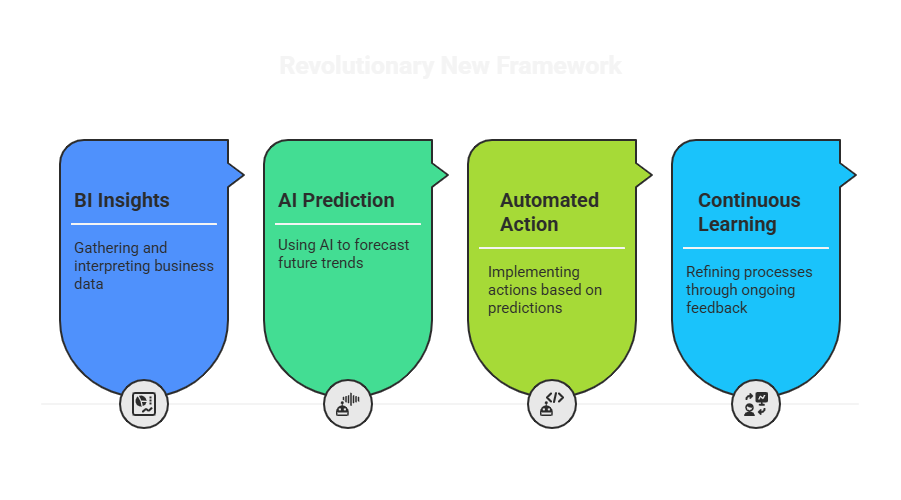How AI Agents Are Redefining Business Intelligence
Transforming data insights into real-time, AI-powered action.

The Death and Rebirth of Business Intelligence
Business Intelligence is experiencing its most dramatic transformation since the first spreadsheet was created. For decades, BI has been the final destination in our data journey, a place where insights were born, displayed on dashboards, and then often forgotten. But artificial intelligence agents are fundamentally rewiring this paradigm, transforming BI from a reactive endpoint into a proactive starting point for autonomous business operations.
The traditional model is crumbling: Data → Analysis → BI Dashboard → Human Decision. In its place, a revolutionary new framework is emerging: BI Insights → AI Prediction → Automated Action → Continuous Learning. This isn't just an evolution—it's a complete reimagining of how businesses operate in the age of artificial intelligence.

Why Traditional BI Models Are Failing Modern Business
The Dashboard Graveyard
Traditional Business Intelligence systems have created what we call "dashboard graveyards", beautiful visualizations that nobody acts upon. The old BI model followed a frustratingly linear path:
- Generate reports from historical data
- Create dashboards to visualize trends
- Present findings to stakeholders
- Hope someone acts on the insights
The fatal flaw? Humans became the bottleneck. By the time insights travelled from data warehouse to dashboard to decision-maker, market conditions had already shifted. We were masters of hindsight, prisoners of the past, always one step behind in an increasingly fast-paced business environment.
Explore this guide to the 13 best dashboard software and tools for 2025, featuring detailed comparisons and expert selection tips.
The Speed Problem
In today's hyper-connected economy, competitive advantage is measured in milliseconds, not months. Traditional BI systems that require weekly reports and quarterly reviews are simply too slow. While companies were scheduling meetings to discuss their KPIs, their AI-powered competitors were already adapting their strategies in real-time.
The AI-Powered BI Revolution: From Reactive to Autonomous
Predictive Intelligence as the New Foundation
Modern AI-driven BI systems don't just tell you what happened; they predict what will happen next and automatically respond to those predictions. This represents a fundamental shift from descriptive analytics to prescriptive analytics powered by machine learning algorithms.
Instead of asking "What were our sales last quarter?", intelligent BI systems answer "Based on current market trends, social sentiment, and historical patterns, here's what we should do to maximize revenue next quarter, and I've already started implementing those changes."
Dive deeper into how Azure-based BI consulting can modernize your data strategy and empower real-time decision-making.
The Five-Stage AI-Powered Business Operating System
The new BI paradigm operates through a continuous five-stage cycle:
Stage 1: Foundational Intelligence Generation - BI systems process vast amounts of structured and unstructured data to generate baseline insights about business performance, market conditions, and operational efficiency.
Stage 2: Predictive Scenario Modeling - AI models analyze patterns and external factors to predict multiple future scenarios, providing probability assessments that consider a range of factors, from supply chain disruptions to shifts in consumer behavior.
Stage 3: Autonomous Decision Execution - Intelligent agents automatically execute decisions based on predictive models, whether that's adjusting pricing, reallocating resources, or modifying marketing campaigns.
Stage 4: Real-Time Outcome Analysis - The system continuously monitors the results of automated decisions, measuring actual outcomes against predicted scenarios.
Stage 5: Continuous Learning and Optimization - Machine learning algorithms refine their models based on real-world results, improving future predictions and decision-making accuracy.

Real-World Applications: The Future Is Already Here
E-Commerce: From Sales Reports to Autonomous Commerce
Traditional Approach: Marketing teams analyze weekly sales reports, manually adjust product positioning, and hope their adjustments are effective.
AI-Powered Future: Intelligent systems predict demand fluctuations based on weather patterns, social media trends, and economic indicators. AI agents automatically adjust pricing strategies, optimize inventory levels, and personalize customer experiences, all while continuously learning from customer interactions.
Example: An AI system detects early signs of increased demand for winter coats based on weather forecasts and social media sentiment. It automatically adjusts pricing, increases supplier orders, and modifies ad targeting, three weeks before the demand spike occurs.
Marketing: From Campaign Analytics to Autonomous Optimization
Traditional Approach: Monthly campaign performance reviews lead to strategic adjustments for the next quarter.
AI-Powered Future: AI agents optimize marketing spend across channels in real-time, automatically shifting budgets from underperforming campaigns to high-conversion opportunities within minutes of detecting performance changes.
Supply Chain: From Logistics Reports to Predictive Orchestration
Traditional Approach: Quarterly supply chain reviews identify inefficiencies after they've already impacted operations.
AI-Powered Future: AI agents continuously monitor global supply networks, predicting disruptions before they occur and automatically rerouting shipments, adjusting supplier relationships, and optimizing inventory distribution.
The Strategic Implications: Why This Shift Changes Everything
Speed: The New Competitive Weapon
When BI becomes the starting point for autonomous operations, decisions happen in milliseconds rather than meetings. This dramatic acceleration creates overwhelming competitive advantages for early adopters. While traditional companies are still analyzing last quarter's performance, AI-powered organizations are already optimizing for next quarter's opportunities.
Precision and Scale: Eliminating Human Limitations
AI-powered BI systems can optimize thousands of decisions simultaneously without fatigue, bias, or delay. They can process complex multi-variable scenarios that would overwhelm human decision-makers, while maintaining consistent quality across all decisions.
Foresight: From Reactive to Preventive
Perhaps most importantly, this new model shifts businesses from reactive problem-solving to preventive opportunity creation. Instead of fixing problems after they occur, AI-powered BI systems prevent problems by predicting and addressing them before they impact operations.
Preparing for BI 2.0: Strategic Considerations for Business Leaders
Infrastructure Requirements
Organizations preparing for this transformation need to invest in:
- Real-time data integration systems that can process streaming information
- Advanced machine learning platforms capable of continuous model training
- API-first architectures that enable seamless communication between BI systems and operational tools
- Cloud-native solutions that can scale dynamically with business needs
Cultural Transformation
The shift to AI-powered BI requires more than technology; it demands a cultural transformation. Organizations must:
- Embrace autonomous decision-making while maintaining appropriate oversight
- Develop AI literacy across all business functions
- Create new governance frameworks for AI-driven operations
- Foster continuous learning mindsets that adapt to rapidly evolving capabilities
The Competitive Reality: Lead or Be Left Behind
The companies that will dominate markets in 2030 won't be those with the most sophisticated dashboards or the largest data science teams. They'll be organizations whose BI systems seamlessly integrate with AI agents that predict, decide, and act autonomously while continuously improving their performance.
This transformation is already underway. Forward-thinking organizations are building AI-powered BI systems that operate as the nervous system of their business, sensing opportunities and threats, predicting outcomes, and taking action—all faster than human cognition can process.
Discover the key challenges of integrating AI into BI and practical strategies to overcome them.
Conclusion: The Future of Business Intelligence Is Autonomous
The great BI shift represents more than a technological upgrade; it's a fundamental reimagining of how businesses operate. As we move from BI as an endpoint to BI as a starting point, organizations must prepare for a future where intelligence doesn't just inform decisions, it makes them.
The question isn't whether this transformation will happen. The question is whether your organization will lead this revolution or struggle to catch up with competitors who've already embraced the autonomous future of business intelligence.
The age of passive dashboards is ending. The era of intelligent, autonomous business operations has begun. Are you ready to make the shift?
FAQ's
1. What is the “Great BI Shift”?
The Great BI Shift transforms Business Intelligence from static dashboards into AI-powered systems that predict outcomes, automate actions, and continuously optimize processes, enabling faster, proactive, and more precise decisions that keep businesses ahead of rapidly changing market conditions.
2. Why are traditional BI models failing today?
Traditional BI depends on past data and slow human decisions, creating delays and “dashboard graveyards.” By the time insights are reviewed, market conditions shift. Modern business requires AI-powered, real-time decision-making to remain competitive and responsive in fast-moving environments.
3. How does AI-powered BI improve decision-making speed?
AI-powered BI analyzes data instantly, executes actions automatically, and monitors outcomes continuously. This eliminates human bottlenecks, enabling businesses to seize opportunities and prevent issues in real-time, often before competitors even identify a change in the market.
4. What infrastructure is needed for AI-driven BI?
AI-powered BI needs real-time data integration, continuous machine learning, scalable cloud-native platforms, and API-first architecture. These ensure systems can adapt quickly, interact seamlessly with operations, and optimize thousands of complex decisions without delays or performance issues.
5. What cultural changes are required for AI in BI?
Organizations must embrace autonomous decisions with oversight, build AI literacy across teams, and create governance frameworks. A culture of adaptability and continuous learning is critical for effectively collaborating with AI systems and maximizing their business impact.

